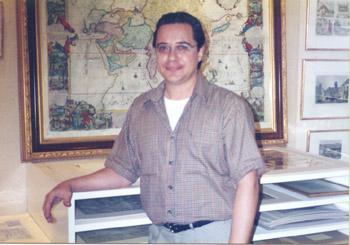IF YOU DON'T LIKE IT, YOU CAN BRING IT BACK

That's Joerg Kohler's motto. He is an antiquarian, and he runs the Old Maps & Prints shop in the River City Complex in Bangkok. He compares selling old maps and prints to buying shares on the stock market. "There is no problem for me in taking them back. If a customer buys a map of Siam, and then gets bored with it and wants to trade it in for a similar map of Burma, that's fine with me. After all, only satisfied customers come back."
 Joerg
Kohler
Joerg
Kohler
Mr Kohler says, "The price of my prints ranges from Bt1,000 to Bt5,000; and my maps from Bt5,000 to Bt20,000. I must sell according to international market prices. The less expensive items are usually from the nineteenth century, and they look a little modern. They are a link between the old and the new maps. They have a modern face, but they are made using a printing technique. The maps that have a higher value show a certain discovery or an original coloring or idea for the first time."
Describing the evolution of print and making paper Mr Kohler says, "There are three main types of print (no off-sets as they are all reproductions) The oldest is relief. The second is intaglio (or engraving) and the third, is surface printing or lithography. Only cotton and hemp were used for making paper up until 1800, but then wood started to be used. The effect on the paper was very noticeable as when you exposed it to sunlight it became brown, it would break (like potato chips), and it started to attract insects too."
Advice for first-time buyers? "Buying art is a matter of trust especially if you are not a collector. A customer will come into my place and say `I have this much money to spend give me a good piece.' But it really all depends on how much money they want to spend.
Shopping for a print? "It all depends on what people want. Do they want an old map or print for decorative reasons? Are they collectors? Who do they want to buy the print for? If it is for a gift, I usually try to find out about the profession of the person the gift is intended for, and then suggest the appropriate print.
"If the customer is buying an old map or print for themselves I think that it is important that they buy a print that they like, not just one they think will increase in value. They have to go home and look at it on the their wall every day so it should be nice otherwise why don't they just tack up a Bt1,000 note on their wall."
How can you spot a phony? Each print should have a short description of the print in question, the technique used, the publishing date, the publishing location, the name of the engraver, and the name of the person who originally drew the print. Kohler notes, "Many prints come with a certificate, and the larger, and more gold the certificate contains the more suspicious I usually am. A simple description with all the facts one can collect on the item is enough."
If you want more information about old maps and prints, Sotheby’s and Christies both publish annual reports detailing items they’ve auctioned. (But keep in mind the auctioneer’s tax, and, since mostly dealers attend the auctions, prices will be higher.) Good books are hard to come by here in Bangkok, but, if you can get your hands on them, Kohler recommends the following as invaluable guides: Thieme/Becher Lexicon of Art; Brunet’s Manuel de librairie de livre; Leo Bargrow’s History of Cartography; Tooley’s Dictionary of Mapmakers and Tooley’s English Books with Coloured Plates; Cordier’s Biblioteca Indosinica; and Colas’ Bibliographie generale du costume de la mode.
Tips for buying and bargaining? Kohler says, "Never buy anything framed. Make sure you look on the back side and see if there is any evidence of repairs, or fungus etc. You can you use these as possible bargaining chips. And, if it is a copper engraving you should always be able to see the size of the original copper plate that was used. If the plate mark has been trimmed the value of the piece goes down (similar to trimming the perforation off an old stamp).
“Always ask the dealer for the name of a framer who can properly frame your print, someone who uses acid-free matte board, or acid-free matte tape, and one who knows how to fix the paper properly so it doesn’t crack, especially here in
Kohler's mentor was a man named Hans Marcus. A German Jew he had to flee his homeland and hide out in much the same way Anne Frank did. In the house where was hiding, there were lots of books, and many on maps and prints. As he had nothing to do but read he read them over and over, and he developed an almost encyclopedic knowledge as he remembered almost everything read. Kohler recalls how a gang had stole a number of prints from a museum in Britain once and one of the gang members eventually showed up at Marcus's shop in Dusseldorf trying to hawk the prints. Marcus immediately recognized the signature on the prints, and knew that they had came from the missing British collection. He notified the authorities and the gang was eventually pinched.
Old Maps & Prints is open Monday through Saturday from
Contact Info:
Tel: (662) 237-0077(8) Ext# 432
Fax: (662) 639-0785
E-mail: oldmaps@loxinfo.co.th
Finis